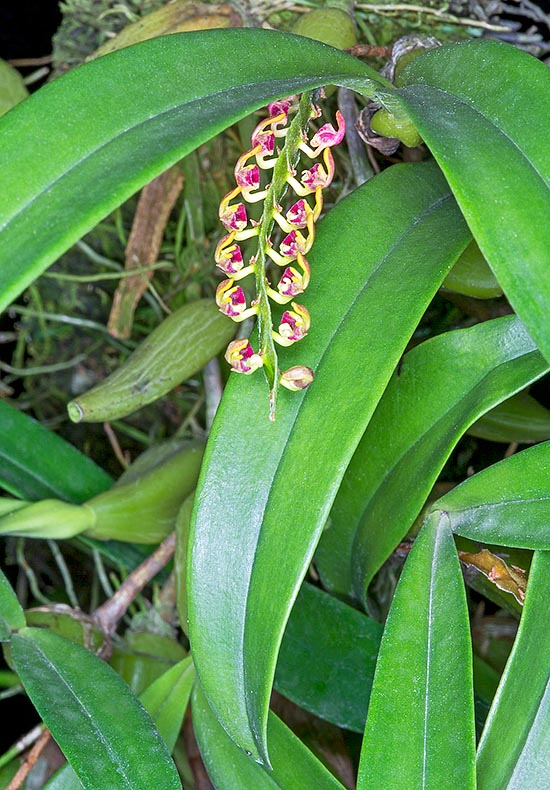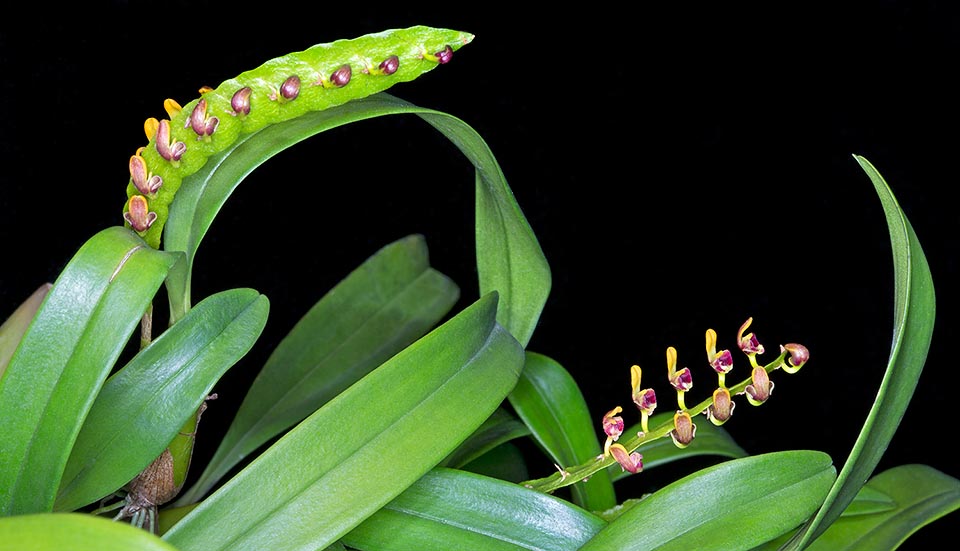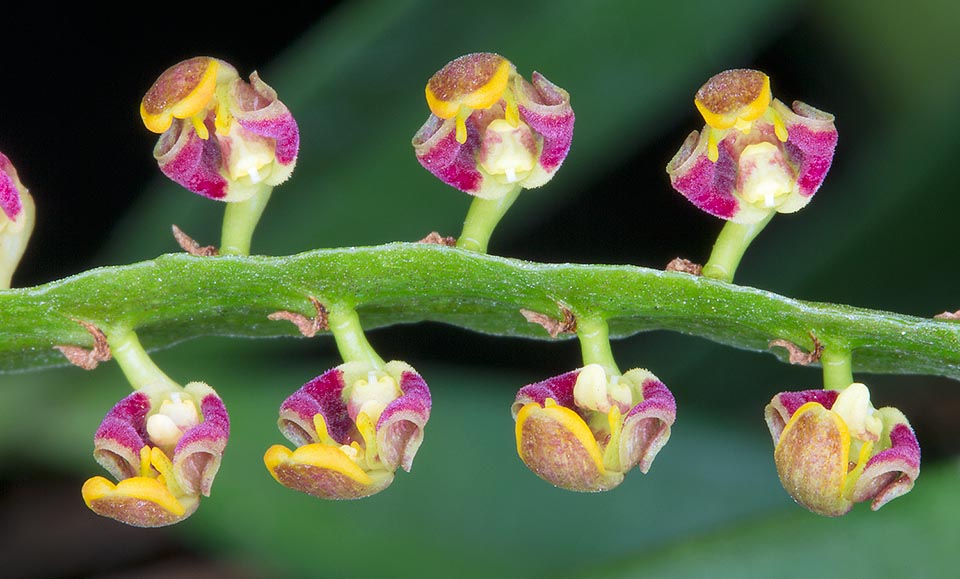Family : Orchidaceae

Text © Pietro Puccio

English translation by Mario Beltramini

Native to tropical Africa, Bulbophyllum falcatum is an odd small epiphyte © Giuseppe Mazza
The name of the genus is the combination of the Greek substantives “βολβός” (bolbos) = bulb and “φύλλον” (phyllon) = leaf, with reference to the leaves growing at the apex of the pseudobulbs; the specific name is the Latin adjective “falcatus, a, um” = sickle-shaped, with reference to the shape of the rachis.
Common names: sickle-shaped leaf bulbophyllum (English).
The Bulbophyllum falcatum (Lindl.) Rchb.f. (1861) is a rather variable epiphytic species with oblong-conical pseudobulbs, 2-5,5 cm long and 1,5 cm broad, spaced of 1-4 cm on a creeping rhizome, provided at the apex of two oblong-lanceolate leaves, 5-20 cm long and 1-3 cm broad, of intense green colour and coriaceous. Inflorescence from the base of the pseudobulb, on a 6-15 cm long peduncle, with flat rachis, falcate, 6-14 cm long and 0,5-1,2 cm broad, of colour from green to green dotted of purple brown, to wholly purple brown, with numerous tiny flowers placed on the median line on both sides and spaced of 0,4-2,5 cm. Spatulate dorsal sepal, 5-9 mm long and 1-4 mm broad, of yellow colour dotted of purple brown outside, ovate-triangular retroflexed lateral sepals with pointed apex, 3,5-6 mm long and 2-3 mm broad, of white dotted of purple colour, oblong petals with obtuse apex, 2-3 mm long and 0,2-0,8 mm broad, of yellowish green colour, curved triangular labellum with obtuse apex, fleshy, mobile, 1,5-3,5 mm long and 2 mm broad at the base, of cream dotted of dark red colour, and 1,5-2 mm long column.
It reproduces by seed, in vitro, and by division with each section provided of at least 3-4 pseudobulbs.
Miniature orchid florifeous and of easy cultivation with characteristic flat sickle-shaped rachis, requires a semi-shady position, medium-high temperatures, with lowest winter night ones not under the 16 °C, and high and constant ambient humidity, 75-85%. The waterings and the nebulizations must be frequent from spring to autumn, more spaced in winter, but without ever allowing the compost to dry up completely, utilizing rain water, by reverse osmosis or demineralized; it’s fundamental a constant ventilation. Monthly fertilizations during the vegetative phase with balanced hydrosoluble products, with microelements, at half the dosage shown on the package.

It’s a quite variable species with oblong-conical, 2-5,5 cm long pseudobulbs, provided at the apex of two oblong-lanceolate 5-20 cm leaves. The flowers generate in flat falcate rachides 6-14 cm long and 0,5-1,2 cm broad. Easy to cultivate in semi-shady position, and high humidity and adequate temperatures © Giuseppe Mazza
It is to be cultivated preferably in pots or baskets rather wide and low, in way to allow the pseudobulbs to freely expand, utilizing a draining and aerated compost that may be formed by medium sliced bark and charcoal fragments, alternatively it can be mounted on trunks, rafts of cork or of roots of arborescent ferns. Repottings and divisions are to be done, when strictly necessary and disturbing the least possible the rooting apparatus, at the vegetative restart signalled by the emission of the new roots.
The species is reported in the appendix II of CITES (species whose trade is internationally ruled).

The unusual and elegant tiny flowers, placed on the median line on both sides, have a yellow spatulate dorsal 5-9 mm sepal, outside dotted of purple brown, purplish retroflexed lateral 3,5-6 mm sepals, oblong 2-3 mm petals and curved triangular labellum with obtuse apex, fleshy, mobile, 1,5-3,5 mm long © Giuseppe Mazza
→ For general notions about ORCHIDACEAE please click here.
